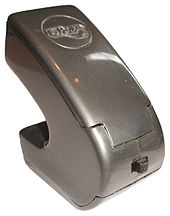E-Bow
The E-Bow is an additional device for electric guitars that is held by the musician with the beating hand and electromagnetically vibrates a string. Similar to the bow of a string instrument, this can produce a long-lasting, even tone. EBow or ebow is the brand name of Heet Sound Products, Los Angeles, California. Inspired by Jimi Hendrix and Iron Butterfly , invented by Greg Heet in 1969 and patented in 1978. The E-Bow has been sold by Heet Sound since the mid-1970s. The principle of operation has also been used in some electric pianos since 1926. See also: Electromechanical musical instrument
functionality
The vibration of a string is electrically amplified by means of a coil that serves as a pick- up and used to operate a second coil. This second coil sits close to the string so that the alternating magnetic field of the second coil can act mechanically on the string. This feedback means that the oscillation is dampened considerably less than without the E-Bow.
So that the magnetic field of the second coil does not disturb the pickup, the coils must be arranged a few centimeters apart. The amplifier is powered by a 9 volt block battery .
With newer versions of the device ( PlusEBow or EBow Plus ) the so-called harmonic mode can be activated via a switch , which does not amplify the fundamental oscillation of the string but the overtone oscillation of the first octave.
Style of play
For the E-Bow to function, it is necessary that both coils are in close proximity to the string. Shallow grooves are made to enable this with the handheld device. With these grooves, the E-Bow can rest on the strings to the left and right of the string to be played and is thus optimally positioned. In addition, vibrations of the neighboring strings on which the E-Bow rests are suppressed.
The device picks up even the smallest vibrations and converts them into a sustained tone. With the E-Bow on, it is sufficient to press the corresponding string onto the guitar's fingerboard . By pressing the E-Bow down on the strings so that it lightly touches the vibrating string, an effect reminiscent of the sound of a sitar can be created.
Sound samples
The E-Bow was used by well-known bands and guitarists.
- The song E-Bow the Letter by REM makes reference to the E-Bow. Guitarist Peter Buck used him for solo work, among other things.
- Andy Timmons uses it for his title Beautiful, Strange .
- Eddie Vedder from Pearl Jam played his guitar on the track Wishlist with the E-Bow.
- Radiohead's Ed O'Brien uses the E-Bow repeatedly on recordings and live.
- James Hetfield , guitarist and singer of the metal band Metallica , is said to have used an e-bow to write the string accompaniment for the song Nothing Else Matters .
- Martin Gore from Depeche Mode uses an electric bow for Walking in My Shoes' guitar solo .
- Jon Hudson from Faith No More uses an e-bow at Stripsearch .
- Sigur Rós use an electric bow in the song Untitled 6 from the untitled album () (2002), although the band usually plays the guitar with a cello bow. The working title of this song is E-Bow .
- Dark Tranquility used an e-bow for the song The Grandest Accusation from the album We Are the Void .
- Paul Banks of Interpol plays the song Take You On A Cruise an E-Bow.
- The bassist Michael Manring uses the E-Bow on the E-Bass.
- Noel Gallagher of Oasis uses the E-Bow in its released in 1996 single Do not Look Back in Anger .
- The Edge of U2 used frequently an E-Bow with live versions of With or Without You and The Unforgettable Fire .
- Peter Koppes from The Church uses an e-bow in the song Under the milky way .
- Stuart Adamson used an e-bow on some tracks by the band Big Country , including at the beginning and end of Eiledon from the album The Seer
- Torsten de Winkel , guitarist of the band Hattler , and Jochen Arbeit , guitarist of the band Einstürzende Neubauten , often use an e-bow together with a pitch shifter , which adds a predetermined interval to the notes of the guitar .
- The pianist and composer Volker Bertelmann (known under the stage name Hauschka) uses the E-Bow among other preparations on his concert grand.
- Troy Donockley of Nightwish on While Your Lips Are Still Red (Live at Wembley Arena , 2015)
Others
With the E-Bow, sustained sounds can also be produced on a grand piano with the holding pedal depressed . Due to the different design and larger mass of piano strings, this is only possible in the middle register of the instrument. Lower strings can also be stimulated by using multiple e-bows on the same string, but then usually vibrate at a certain overtone frequency of the corresponding string instead of its fundamental frequency. With the highest piano strings, on the other hand, the string tension is too great to be excited with the E-Bow.

